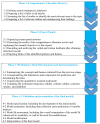A model of the organizational resilience of hospitals in emergencies and disasters
- PMID: 38914937
- PMCID: PMC11197230
- DOI: 10.1186/s12873-024-01026-6
A model of the organizational resilience of hospitals in emergencies and disasters
Abstract
Background: In the health system, hospitals are intricate establishments that offer vital medical services. Their resilience plays a crucial role in mitigating the societal repercussions of disasters. A hospital must possess the capacity to withstand risks, preserve its fundamental structure and operations, and enhance its preparedness by augmenting various capabilities and promptly recovering from the impacts of potential risks. It enables the hospital to attain a heightened level of readiness. Therefore, this study aimed to develop a resilience model tailored for hospitals to navigate crises and disasters effectively.
Methods: This mixed-method study was conducted in 2023 in three phases: (1) Identification of the factors influencing the organizational resilience of the hospital, (2) Evaluation of the influential factors by an expert panel. (3) Following the standardization process, we administered 371 questionnaires to individuals, such as university staff managers and supervisors, nursing managers, and research unit managers. The sample size was determined by multiplying the components by 10, resulting in 360 (10 * 36). Therefore, we selected a sample size of 371 participants. Structural Equation Modeling (SEM) was employed to examine the causal relationships between variables. These steps were performed using SPSS 25.0 and AMOS 22 software. Finally, we identified and presented the final model. We utilized AMOS 22 and applied the SEM to assess the correlation between the variables, with a significance level of 0.05.
Results: Findings indicate that the appropriate modeling identified five dimensions comprising 36 components. These dimensions include vulnerability, preparedness, support management, responsiveness and adaptability, and recovery after the disaster. The model demonstrates a good fit, as indicated by the X2/d indices with a value of 2.202, a goodness of fit index (GFI) of 0.832, a root mean square error of estimation (RMSEA) of 0.057, an adjusted comparative fit index (CFI) of 0.931, and a smoothed fit index (NFI) of 0.901.
Conclusion: Enhancing hospital resilience is crucial for effective preparedness and response to accidents and disasters. Developing a localized tool for measuring resilience can help identify vulnerabilities, ensure service continuity, and inform rehabilitation programs. The proposed model is a suitable framework for assessing hospital resilience. Key factors include human resource scarcity, hospital specialization, and trauma center capacity. Hospitals should prioritize efficient resource allocation, information technology infrastructure, in-service training, waste management, and a proactive organizational framework to build resilience. By adopting this approach, hospitals can better respond to crises and disasters, ultimately reducing casualties and improving overall preparedness.
Keywords: Disaster; Emergency; Hospital; Model; Resilience.
© 2024. The Author(s).
Conflict of interest statement
The authors declare no competing interests.
Figures
Similar articles
-
Exploring hospital resilience protective or risk factors: lessons for future disaster response efforts.Front Public Health. 2024 Mar 27;12:1378257. doi: 10.3389/fpubh.2024.1378257. eCollection 2024. Front Public Health. 2024. PMID: 38601510 Free PMC article.
-
The impact of surge capacity enhancement training for nursing managers on hospital disaster preparedness and response: an action research study.BMC Emerg Med. 2024 Aug 26;24(1):153. doi: 10.1186/s12873-024-00930-1. BMC Emerg Med. 2024. PMID: 39183329 Free PMC article.
-
Challenges of providing of special care services in hospitals during emergencies and disasters: a scoping review.BMC Emerg Med. 2024 Dec 18;24(1):238. doi: 10.1186/s12873-024-01160-1. BMC Emerg Med. 2024. PMID: 39695959 Free PMC article.
-
A new framework for assessing hospital crisis management based on resilience engineering approach.Work. 2016 Jun 14;54(2):435-44. doi: 10.3233/WOR-162329. Work. 2016. PMID: 27315414
-
"One community at a time": promoting community resilience in the face of natural hazards and public health challenges.BMC Public Health. 2023 Dec 14;23(1):2510. doi: 10.1186/s12889-023-17458-x. BMC Public Health. 2023. PMID: 38097956 Free PMC article.
Cited by
-
Evaluating the efficacy of full-scale and tabletop exercises in enhancing paramedic preparedness for external disasters: A quasi-experimental study.Medicine (Baltimore). 2024 Dec 6;103(49):e40777. doi: 10.1097/MD.0000000000040777. Medicine (Baltimore). 2024. PMID: 39654246 Free PMC article. Clinical Trial.
-
Structural Equation Modelling of Retinopathy of Prematurity Treatment Integrating Both Physical and Clinical Effects.J Clin Med. 2025 Jan 7;14(2):297. doi: 10.3390/jcm14020297. J Clin Med. 2025. PMID: 39860303 Free PMC article.
References
-
- Guha-Sapir D, Vos F, Below R, Ponserre S. Annual disaster statistical review 2011: the numbers and trends. 2012.
-
- Albanese J, Birnbaum M, Cannon C, Cappiello J, Chapman E, Paturas J, et al. Fostering disaster resilient communities across the globe through the incorporation of safe and resilient hospitals for community-integrated disaster responses. Prehosp Disaster Med. 2008;23(5):385–90. doi: 10.1017/S1049023X00006105. - DOI - PubMed
MeSH terms
LinkOut - more resources
Full Text Sources
Medical
Miscellaneous





